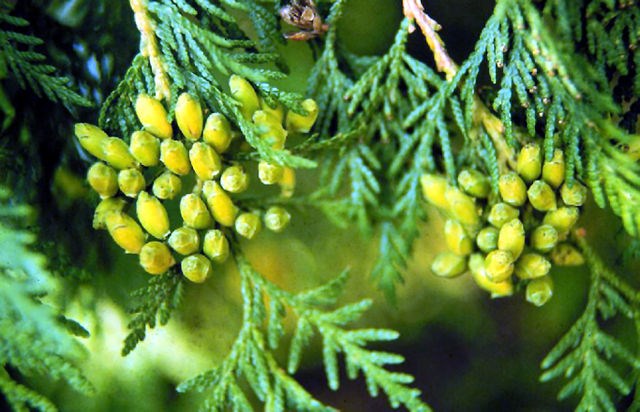As we are enjoying a nice autumn, it is a good idea to think ahead about what chores will need to be done prior to the big freeze up. As our trees and shrubs are an important aspect of the landscape it is a good idea to think about how to ensure they not only go into winter in good shape but also remain green and lush right into the growing season next year. This article is mostly focused on evergreens but can also be applied to sunscald on the trunks of deciduous trees.
Evergreens in the landscape provide shelter for our feathered friends and also help to control snow and wind. They are aesthetically important as their evergreen foliage is so appreciated while the rest of the landscape exhibits so many shades of grey. Of the many evergreens we can grow, cedars seem to be the evergreen that is most susceptible to winter damage. Read on to help ensure your evergreen cedar does not turn into shades of brown.
The most common cedar of our landscapes is the eastern white cedar (Thuja occidentalis). It is found naturally throughout North Eastern North America. Traditionally, the eastern white cedar was used by aboriginals to prevent scurvy as it contains Vitamin C. This practice was passed onto French settlers which gave rise to the name arborvitae or “tree of life”. The wood is valuable as it is resistant to rot and insects. Traditionally it was used for the framework of canoes but today it has many uses including posts, poles, shingles and even shelter for alternative livestock operations.
Although the eastern white cedar is not found naturally in Saskatchewan, they can tolerate our extremely dry and cold winters with a little extra care. Over winter, these cedars need to have adequate shelter from the desiccating effects of our winter sun and wind to maintain their evergreen colour. The browning that can occur is a result of the desiccation or drying of the leaf tissues. As these leaves are still living, when the warm early spring sunshine heats them up and actually causes respiration within the plants to increase. The by-product of this process is that water is given off by the plant which in turn causes drying and browning of the leaf tissue as the ground is still frozen and the plant cannot bring up water to offset this water loss as it would during the summer months.
Choosing the right cultivar will help to ensure you are successful in incorporating cedars you’re your landscape. ‘Brandon’ (4 m tall by 1.5 m wide) is likely the most common cedar grown and has good hardiness. ‘Holmstrup’ (2 m tall and 1 m wide) has a nice green colour only topped by ‘Smaragd’ (4m tall by 1.5 m wide) which exhibits the most intense green. For good sized globe cedars try `Woodwardii’, `Globosa’ or `Little Giant’ (all about 2 m tall and wide). If you are looking for smaller selections try `Hetz Midget’ (1 m tall by 1 m wide) or `Little Gem’ which will be of similar height but slightly wider than ‘Hetz Midget’.
Proper care is essential to keep your cedar green. Throughout the growing season, it is important to ensure that these evergreens receive enough moisture. This past summer was very dry and all trees and shrubs should have received supplemental irrigation in order to thrive. It is also important to water all trees and shrubs deeply and thoroughly in a dry year just prior to freeze up. Throughout the winter, they need to receive shelter from the wind and shade from the sun. Planting them on an east or north exposure is a good choice. If you have the misfortune of your cedars living in a location that is not sheltered, it is best to provide some protection. You need to minimize their exposure to the late-afternoon sun. Even in winter, the sun has a lot of power and will result in a daily freeze/thaw cycle that is extremely damaging to the tissues of the cedar.
It used to be recommended to wrap your cedars in burlap for the winter – but this is really not the best choice. The absolute best way to protect your cedars from winter browning is to tap some poles into the ground close to the cedars. (It is recommended that you do this prior to the ground freezing solid!) Create a screen using burlap (or other suitable material) that will serve as a shield for wind and sun. As a bonus – you can still enjoy the great green that your cedars provide to the landscape.
It is not recommended that you use anti-desiccant sprays. They work by coating the leaves with a very thin layer of wax. These “miracle” products never quite deliver as promised and are definitely not a substitute for proper care.
Hanbidge is the Lead Horticulturist with Orchid Horticulture. Find us at ; by email at [email protected]; on Facebook @orchidhort and Instagram at #orchidhort. Tune into GROW Live on our Facebook page or check out the Youtube channel GROW




